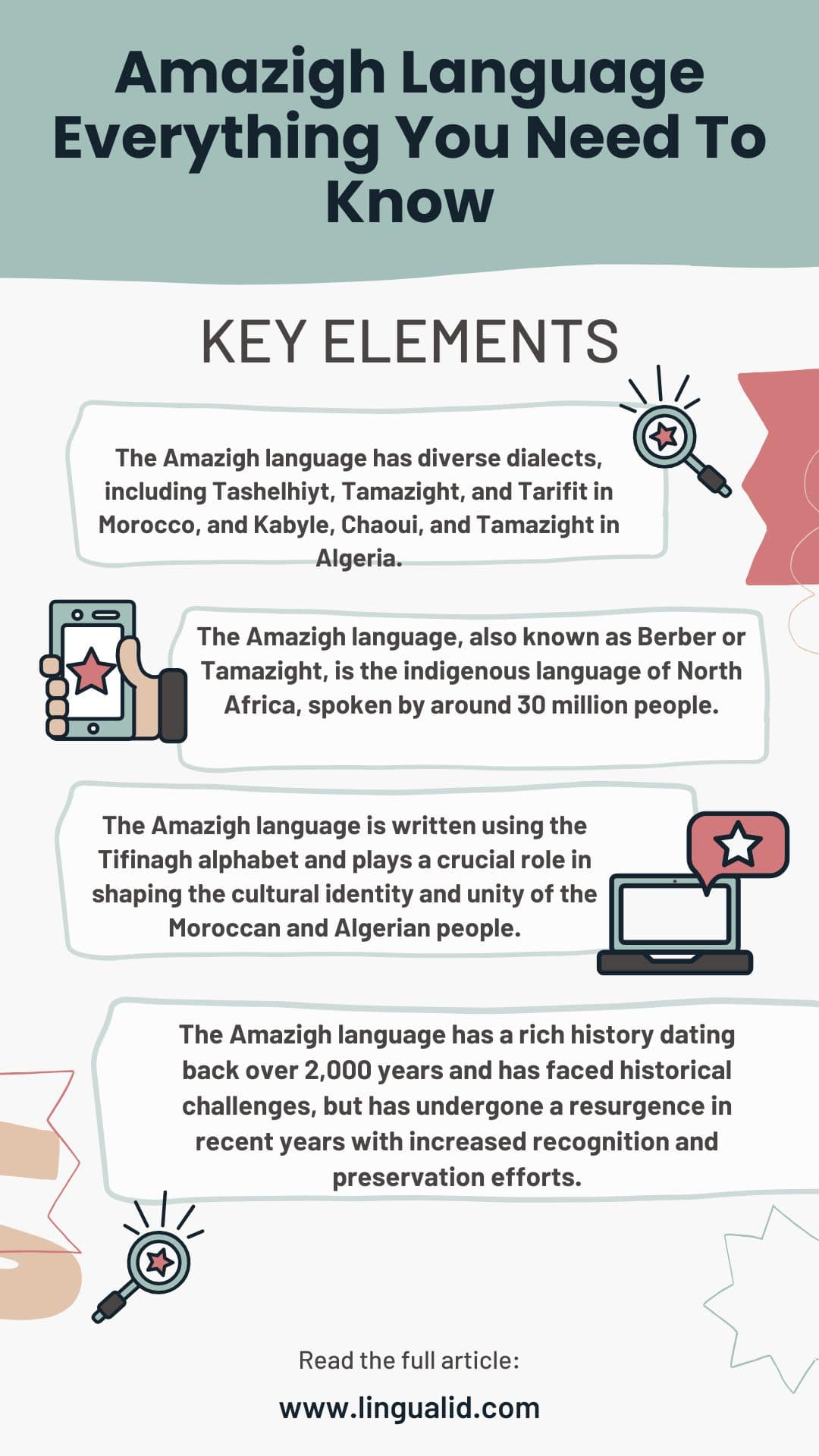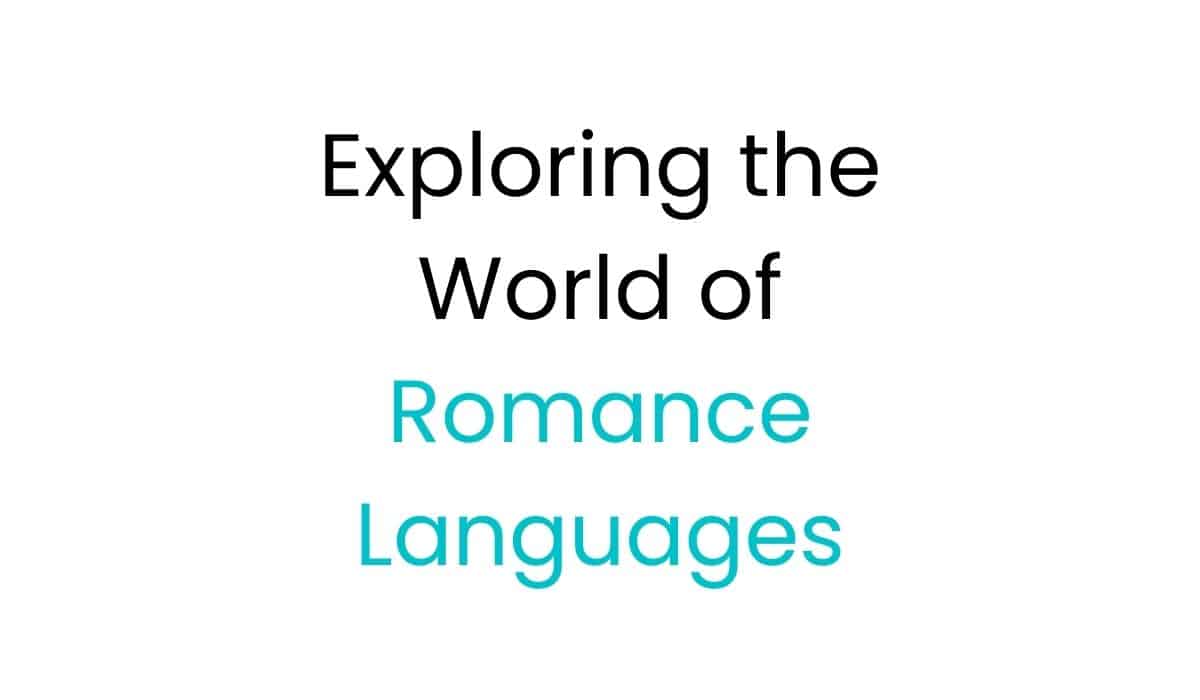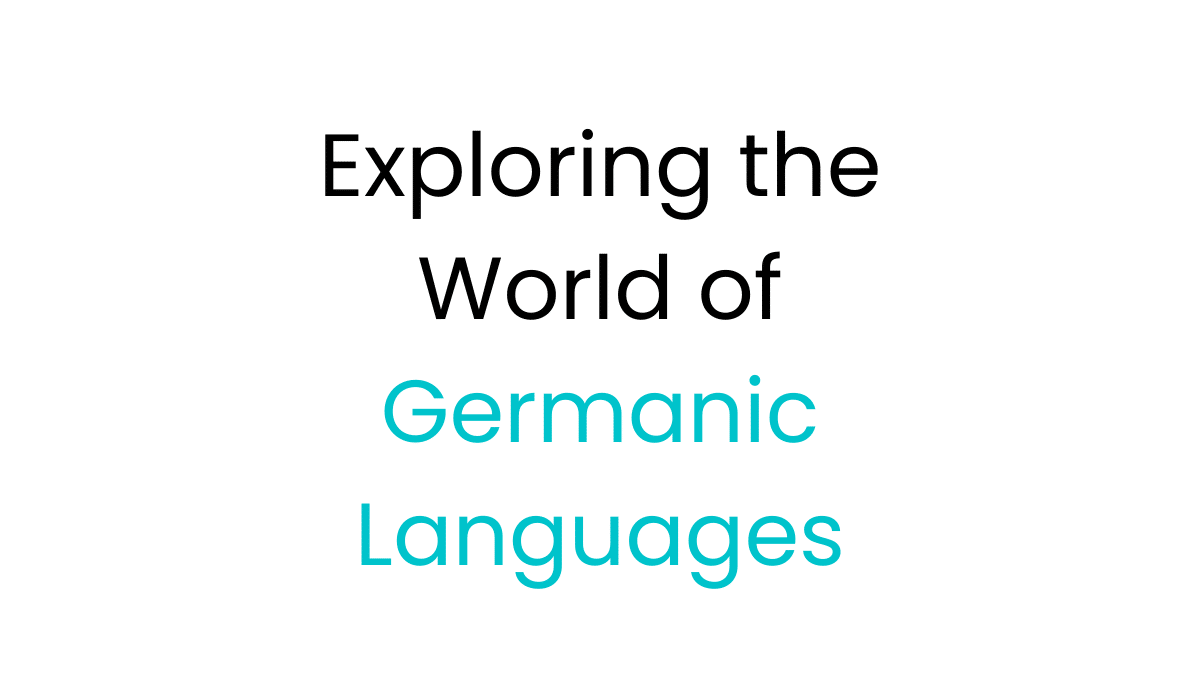The Amazigh language, also known as Berber or Tamazight, is spoken by the Amazigh people in North Africa. It has a rich history of over 2,000 years. This language is a key part of the region’s culture.

It has many dialects, like Tashelhiyt, Tamazight, and Tarifit in Morocco. In Algeria, you’ll find Kabyle, Chaoui, and Tamazight. The Tifinagh alphabet is used to write it. This language helps unite the people of Morocco and Algeria.
Despite past challenges, the Amazigh language is making a comeback. There’s more recognition and efforts to keep it alive in North Africa.
Key Takeaways
- The Amazigh language, also known as Berber or Tamazight, is the indigenous language of North Africa, spoken by around 30 million people.
- The Amazigh language has diverse dialects, including Tashelhiyt, Tamazight, and Tarifit in Morocco, and Kabyle, Chaoui, and Tamazight in Algeria.
- The Amazigh language is written using the Tifinagh alphabet and plays a crucial role in shaping the cultural identity and unity of the Moroccan and Algerian people.
- The Amazigh language has a rich history dating back over 2,000 years and has faced historical challenges, but has undergone a resurgence in recent years with increased recognition and preservation efforts.
- The term “Amazigh” means “the free man” and the Amazigh people are the indigenous people of Morocco and North Africa.
- Key Takeaways
- Historical Background and Significance
- Diversity Within the Dialect Continuum
- Phoenician, Punic, Latin, and Arabic Influences
- Berber Languages in North Africa
- What is the Amazigh language?
- What is the linguistic diversity of the Amazigh language?
- How is the Amazigh language written?
- What is the status of the Amazigh language today?
- How is the Amazigh language related to the Afroasiatic language family?
- What is the significance of the Amazigh language in North African culture?
- What are the main challenges faced by the Amazigh language?
Introduction to the Amazigh Language
Historical Background and Significance
The Amazigh language, also known as Berber or Tamazight, has a long history in North Africa. It dates back about 2,000 years. This language is key to the Berber people’s culture and identity.
It helps keep their traditions alive and lets them share their values. Berber-speaking people live in many parts of North Africa and beyond. Millions speak it in Morocco and Algeria, and smaller groups in other countries.
The Amazigh language has faced many challenges over the years. Despite the influence of other languages, it remains a vital part of North Africa’s culture. It carries stories, customs, and beliefs from one generation to the next.
“The Amazigh language is not just a means of communication, but a reflection of the rich cultural heritage and identity of the North African people.”
Today, the Amazigh language is still important in North Africa. Efforts to recognize and promote Berber languages show its value. This includes official recognition in Morocco and Algeria.
The Amazigh Language and Its Place in the Afroasiatic Family
The Amazigh language is part of the Afroasiatic language family. This family includes many languages from North Africa and the Middle East. The Amazigh language stands out as a unique branch, showing its own special traits.
Even though it’s related to languages like Arabic and Hebrew, Amazigh has its own special features. This shows the rich cultural and linguistic diversity in the Afroasiatic family. Here are some interesting facts:
- About 25 million people speak the Amazigh (Berber) languages in Northern Africa.
- Tamasheq is the most spoken Tuareg dialect, with around 378,000 speakers in Mali.
- Kabyle (Taqbaylit) is spoken by 5 million people in Algeria and has a total of 5.59 million speakers globally.
- Central Atlas Tamazight (Tamaziɣt) is spoken by around 4.7 million people with the majority of speakers located in Morocco.
- Tachelhit (Shilha) has 7 million speakers in Morocco.
- Tarifit (Riffian) is spoken by 4.2 million people in Morocco.
The Amazigh languages use different scripts like Tifinagh, Latin, and Arabic. This shows the mix of cultural and linguistic influences in the area.
“The Amazigh language represents a distinct branch within the Afroasiatic family, showcasing the rich linguistic diversity of North Africa and the Middle East.”
The history of the Amazigh language highlights the lasting cultural impact of the Amazigh people. They have lived in North Africa for thousands of years, influencing the region’s language.
The Complexities of Berber Languages
The Amazigh dialects, also known as Berber languages, are known for their rich diversity and complexity. Spoken by about 33 million people globally, they form a dialect continuum. This means that nearby varieties can be understood by each other. Yet, the Berber languages also show significant differences, making it hard to define clear boundaries between them.
This diversity showcases the rich cultural heritage of Amazigh-speaking communities in North Africa. Linguists are still discussing the best way to categorize the Berber languages. This is because their history of blending and changing makes it tough to use traditional ways of classifying languages.
Diversity Within the Dialect Continuum
It’s believed that there are up to 100 different Berber languages and dialects. The main groups are Northern, Southern, and Eastern Berber, each with its own traits. For example, Northern Berber includes Tarifit, Tamazight of the Middle Atlas, and Kabyle Berber. Southern Berber includes Zenaga, Tashelhiyt, and Tuareg Berber.
| Berber Language Subdivision | Examples |
|---|---|
| Northern Berber | Tarifit, Tamazight of the Middle Atlas, Figuig Berber, Kabyle Berber, Tashawit, Berber of Mzab, Berber of Ouargla |
| Southern Berber | Zenaga, Tashelhit, Tetserret, Tuareg Berber |
| Eastern Berber | Berber spoken in Siwa, Sokna, El-Fogaha, Yefren, Zuara, Ghadames |
Even though nearby Berber varieties can be understood, the overall diversity of the Berber language family is still a topic of debate among linguists.
The Multifaceted Meaning of “Tamazight”
“Tamazight” is a term with deep meaning in the Amazigh languages. It’s often linked to “Berber languages,” but it can also mean a specific type, like Central Atlas Tamazight. Recently, there’s been a push to celebrate the Amazigh language and culture. Countries like Morocco and Algeria have made Tamazight a national language.
In Morocco, Standard Moroccan Tamazight was created by mixing three Amazigh languages. This shows the rich diversity of Amazigh languages. In Algeria, Tamazight became an official language in 2016. This move highlights the effort to protect and honor the Amazigh language.
The Amazigh people have lived in North Africa for over 5,000 years. They are the original people of the area. In Morocco, they make up a big part of the population. They influence the country’s traditions, art, music, and lifestyle. Tamazight, the official language of Morocco, was recognized in 2011. This was a key step in saving Amazigh cultural heritage.
| Statistic | Value |
|---|---|
| Amazigh population in Morocco | Around 40% of the total population |
| Tamazight recognized as official language in Morocco | 2011 |
| Tamazight recognized as official language in Algeria | 2016 |
The Amazigh language has many dialects in Morocco, like Tashelhit, Tamazight, and Tarifit. Tamazight is now an official language in Morocco. But, it’s still a work in progress to include it more in education and public life. This shows the ongoing effort to keep the Amazigh language and culture alive.
Linguistic Lineage and Afroasiatic Roots
The Amazigh language is special in the Afroasiatic language family. This family includes hundreds of languages from North Africa, the Middle East, and Asia. It goes back to pre-Neolithic hunter-gatherers, fascinating many scholars.
Studies show the Amazigh language is similar to Semitic languages like Arabic and Hebrew. This suggests a shared ancestry in the Afroasiatic family. Yet, Amazigh has its own special traits, making it different from others in the family.
The Afroasiatic language family has six main branches: Berber, Chadic, Cushitic, Egyptian, Semitic, and Omotic. While their connections are not as close as Indo-European languages, they still share a common heritage.
| Afroasiatic Language Branch | Number of Speakers |
|---|---|
| Arabic | Approximately 300 million |
| Oromo | 45 million |
| Hausa | Over 34 million |
| Amharic | 25 million |
| Somali | 15 million |
The Amazigh language and others in the Afroasiatic family have deep roots in North Africa and the Middle East. This rich history is still studied by scholars and loved by many, giving us a glimpse into human history and migration.
Prehistoric Origin of the Amazigh Language
The Amazigh language is spoken by the Berber ethnic groups in North Africa. It has ancient roots, dating back to the Paleolithic era. This is when the first people of the region settled and formed communities.
As Amazigh tribes moved across North Africa, they developed different dialects. This happened because of their semi-nomadic lifestyle. They followed the seasons and resources available.
Even though there are few written records from ancient times, scholars have found evidence of the language’s evolution. The Amazigh language has survived and grown, despite external influences and cultural changes.
The Amazigh language’s origins and the growth of its dialects show the rich culture of the Berber people. They have been a key part of North Africa’s history for thousands of years.
Linguistic Influences on the Amazigh Language
Phoenician, Punic, Latin, and Arabic Influences
The Amazigh language comes from North Africa. It has been shaped by many civilizations. The Phoenicians and Punics brought loanwords and features through their trade. The Romans also added Latin elements after conquering the area.
The Arab expansion in the 7th century had a big impact. The Amazigh language took on Arabic words and traits. This shows how North Africa’s culture and language are rich and diverse.
Now, people are working hard to keep the Amazigh language alive. Learning about its history helps us understand North Africa’s cultural and linguistic heritage.
| Linguistic Influence | Impact on Amazigh Language |
|---|---|
| Phoenician and Punic | Introduction of loanwords and linguistic features |
| Latin | Incorporation of Latin elements through Roman conquest |
| Arabic | Absorption of Arabic loanwords and linguistic characteristics |
Historical Significance and Cultural Expression
The Amazigh language is deeply tied to the history and culture of the Berber people in North Africa. It has changed over time, influenced by empires and civilizations. Yet, it remains a key part of North African history and cultural heritage.
The Amazigh language holds the stories, myths, poetry, and literature of the Berber people. It keeps their traditions and values alive. This way, it connects past and present, shaping their cultural identity.
In 2011, King Mohammed VI made Tamazight a national language in Morocco. This move boosted the acceptance of Amazigh cultural aspects in modern Moroccan culture. It was a big step in acknowledging the Amazigh language‘s importance.
The Amazigh belief system and oral traditions have shaped the Amazigh people’s cultural identity. The tribal system in both Amazigh and Moroccan cultures emphasizes kinship. This strengthens the Amazigh language as a bond among people.
Despite facing challenges like political representation and disenfranchisement in Moroccan laws, the Amazigh language is still strong. It shows the cultural resilience and spirit of the Berber communities in North Africa.
Berber Languages Across North Africa
The Amazigh language, also known as the Berber language, is spoken across a vast area in North Africa. It stretches from the Atlas Mountains of Morocco to the vast Sahara of Mali and Niger. These ancient tongues show the rich cultural diversity of the region.
Berber Languages in North Africa
In Morocco, the main Berber languages are Tamazight, Tashelhiyt (Shilha), and Tarifit (Rifian). Amazigh is officially recognized. Algeria also has a variety of Berber languages, including Kabyle, Chaoui, Tumzabt (Mozabite), and Tamazight, which is an official language.
Beyond these countries, the Tamasheq language is common among the Tuareg people in Mali and Niger. Tamazight and Tamasheq are used in Libya. The Siwi language is spoken in Egypt’s Siwa Oasis, showing the widespread and cultural richness of Berber languages in North Africa.
| Country | Amazigh Languages | Population Estimates |
|---|---|---|
| Algeria | Kabyle, Chaoui, Tumzabt (Mozabite), Tamazight | Roughly one-fourth of the population is estimated to be Amazigh. |
| Morocco | Tamazight, Tashelhiyt (Shilha), Tarifit (Rifian) | Amazighs are estimated to make up more than 40% of the population. |
| Mali and Niger | Tamasheq | In the Sahara of southern Algeria and of Libya, Mali, and Niger, the Tuareg number more than two million. |
| Libya | Tamazight, Tamasheq | About 250,000 |
| Egypt | Siwi | About 20,000 |
| Mauritania | Tamasheq | About 200,000 |
| Europe | Different Amazigh dialects | About 4 million |
The Berber languages have a deep history and cultural importance. Their revival as written languages, like Tamazight with a modified Latin script and Tifinagh, is crucial for preserving their heritage.
Challenges and Revitalization Initiatives
Amazigh languages are gaining recognition in North Africa. Yet, they face many challenges. The use of Arabic in administration and education hinders Berber languages in some areas. Globalization and modernization also bring in foreign languages and cultures, threatening the Amazigh tongue.
Despite these obstacles, efforts to revitalize and preserve Amazigh languages are underway. Educational initiatives and cultural festivals help bring these languages back. The official recognition in countries like Morocco and Algeria shows a strong commitment to preserving this heritage.
The involvement of Amazigh activists in the Vienna conference of 1993 and the Amazigh World Congress in 1994 has been key. As
“the first inhabitants of North Africa”
, the Imazighen fight for their cultural and linguistic rights. This is seen in the translation of sacred texts like the Quran into Tamazight.
Efforts to revitalize endangered languages focus on community solidarity and prestige. These actions are vital for preserving human diversity and combating language loss.
- The Moroccan Constitution of 2011 recognized the status of Amazigh language.
- The Institut Royal de la Culture Amazighe (IRCAM) was established in 2001 in Morocco.
- The Constitutional reform in Algeria in 2016 made Amazigh a national language.
- The Algerian Academy of Amazigh Language was established in 2018.
- The Haut Commissariat à l’Amazighité in Algeria was created in 1995.
- Libyan Amazighs have been vocal about their linguistic and cultural rights.
- Tunisia has ongoing efforts for recognition of Amazigh rights.
- Chad, Mali, and Niger Imazighen had acquired educational rights earlier.

Conclusion
The Amazigh language, also known as Berber or Tamazight, is a key part of North Africa’s culture. It has a long history, over two millennia, shaped by many civilizations. This has made the language rich and diverse across the region.
Despite challenges like Arabic dominance and globalization, Amazigh has seen a big comeback. This is thanks to efforts to keep the language alive.
In countries like Morocco and Algeria, Amazigh is now officially recognized. Places like the Institut Royal de la Culture Amazighe (IRCAM) in Morocco are helping. These efforts are key to keeping the Amazigh language vibrant.
As support for Amazigh grows, the future looks bright. The fight for Amazigh rights is ongoing, but progress is clear. The Berber people are determined to keep their language and culture alive.
FAQ
What is the Amazigh language?
The Amazigh language, also known as Berber or Tamazight, is spoken by the Berber people in North Africa. It has a long history, over 2,000 years old. It’s a key part of the region’s culture.
What is the linguistic diversity of the Amazigh language?
The Amazigh language has many dialects. In Morocco, there’s Tashelhiyt, Tamazight, and Tarifit. In Algeria, you’ll find Kabyle, Chaoui, and Tamazight. This shows the rich culture of the Berber-speaking communities.
How is the Amazigh language written?
The Amazigh language uses the Tifinagh alphabet. This script has been important to the Berber people for centuries. It helps unite the Moroccan and Algerian people culturally.
What is the status of the Amazigh language today?
The Amazigh language has seen a comeback in recent years. Morocco and Algeria now officially recognize Tamazight as a national language. This shows a strong commitment to preserving this language and culture.
How is the Amazigh language related to the Afroasiatic language family?
The Amazigh language belongs to the Afroasiatic language family. This family includes languages from North Africa and the Middle East. Despite being related to languages like Arabic and Hebrew, Amazigh has its own unique features.
What is the significance of the Amazigh language in North African culture?
The Amazigh language is deeply connected to the Berber people’s history and culture. It holds their traditions, values, and way of life. It’s crucial for preserving their oral traditions and cultural heritage.
What are the main challenges faced by the Amazigh language?
The Amazigh language faces challenges like Arabic’s dominance in administration and education. Globalization and modernization also threaten it. But, efforts to revitalize and preserve it are underway. This includes educational programs, cultural festivals, and media focused on Amazigh content.
Oualid Cheddadi is the founder of Lingualid, a platform that inspires independent language learners worldwide, regardless of the language they are learning. The name “Lingualid” is derived from the Portuguese word for “language,” “língua,” and the last three letters of Oualid’s name, “Lid.”



